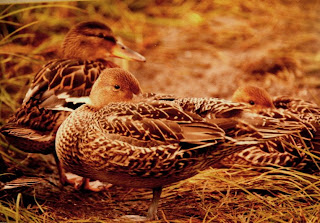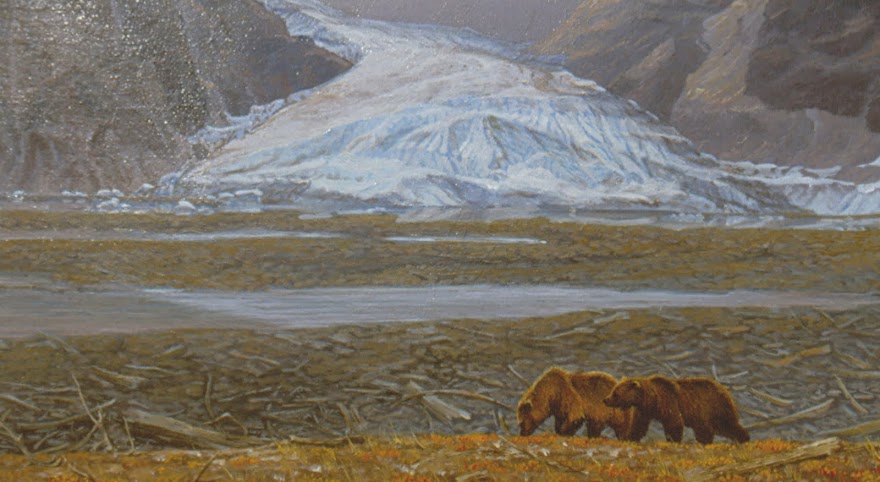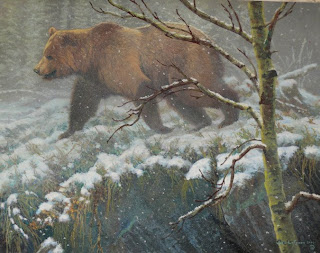Who would want to read a boring discussion about composition? There are many rules, and approaches. The most basic of them are vanishing points,light source, and the rule of thirds. The focal point should contain the greatest contrasts, and on and on. The point is to learn them so you can know when to disregard them.
I usually dont bother with preliminary sketches. I just work out the composition on the board. Sometimes I spend as much time working out the design as I do actually painting it. When I get the proportions right, I look at the line drawing in the mirror, or upside down to see if it still looks right.
Now I'm ready to apply paint. I start at the back of the painting, and work my way forward. The intent is to lay down a solid foundation on which to build the visible parts of the painting. The first coats of paint are applied with an inch wide, square tipped brush. It usually takes two coats of opaque paint to do the job.
Sometimes the foundational coats are lighter in tone, and I apply successive darker strokes. However, the most common situation requires lighter brushwork on top of a darker base. For example, the texture of a mountain, rock, or tree bark are built on top of the darker base. Remember that the colors and tones toward the front of the painting, should be stronger than those in the distance.
Generally, successive coats are thinner than the foundational coats. Avoid the mistake of adding surface details without first creating the overall form underneath. Texures like fur, and feathers come near the end of the painting, and are almost an afterthought. If the underlying form is done right, adding fur, and feathers etc. usually take only minutes to apply, not hours.
The big secret to the style of painting that I do is the application of glazes, and washes. This pulls the whole thing together, and makes it look natural. Easy on the eye. It is the best way to create mood, and atmosphere. Glazes are very thin transparent layers of pigment, without white paint. They are mostly water, with little paint. Washes are the same thing, but include some, or all, white paint. Washes are useful for pushing objects into the background to create the illusion of depth.
I have ruined many perfectly good paintings by being too heavy handed with these techniques. It was a lot harder for me to learn to control glazes, than it was to learn washes. Now I use mostly glazes, and few washes. I use them at varying stages of the painting. Sometimes I cover the whole painting, and sometimes just one small section. Practice is the only way to get it right. Burnt sienna is the best color to use for a glaze. Remember to look at the painting in the mirror often to see if it looks right.
One bugaboo for me has been the final varnish. It has been so difficult to get a uniform finish. After ruining many paintings with bubbling , peeling, or cloudy varnish. Now I only use Windsor Newton, gloss. picture varnish in a spray can.
 This is a photo of some Pintail, and Mallard hens, moulting their feathers at Potter Marsh, south of Anchorage. They are flightless at this point in late summer. I really love the complex, earth- toned pattern of the Pintail hen. It may not be everyone's cup of tea, but it's an interesting subject to paint for me.
This is a photo of some Pintail, and Mallard hens, moulting their feathers at Potter Marsh, south of Anchorage. They are flightless at this point in late summer. I really love the complex, earth- toned pattern of the Pintail hen. It may not be everyone's cup of tea, but it's an interesting subject to paint for me. Here is a lousy photo, but I wanted to use the grass in it.
Here is a lousy photo, but I wanted to use the grass in it. The only sketching I needed for this painting, was the outlines of the duck's anatomy, drawn on a gray gessoboard.
The only sketching I needed for this painting, was the outlines of the duck's anatomy, drawn on a gray gessoboard. I have laid down a plastic vegetable bag to use as a palette, and squeesed out my basic colors. Later I added some burnt sienna to the palette. I like to use plastic bags, because I can fold them over on top of the paint to keep it from drying out. That way I dont waste so much paint, and I can take a break for a while, and come back to where I left off.
I have laid down a plastic vegetable bag to use as a palette, and squeesed out my basic colors. Later I added some burnt sienna to the palette. I like to use plastic bags, because I can fold them over on top of the paint to keep it from drying out. That way I dont waste so much paint, and I can take a break for a while, and come back to where I left off. The first coat of paint is applied to lay a foundation for some background water.
The first coat of paint is applied to lay a foundation for some background water.










 This was one of many bears I photographed in Denali. The original slide looks decent, but I lost so much quality when I scanned it into my computer. I have painted this same bear several times, but always in different settings.
This was one of many bears I photographed in Denali. The original slide looks decent, but I lost so much quality when I scanned it into my computer. I have painted this same bear several times, but always in different settings.













